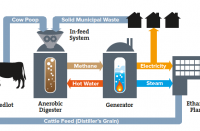Richard Gilbert opens
Waste is what we have used and have no further use for. Incinerating waste, I believe, is a better environmental solution than landfilling.
Richard Gilbert opens
Waste is what we have used and have no further use for. Incinerating waste, I believe, is a better environmental solution than landfilling.
Only a limited amount of waste occurs in nature. Animals produce waste in the form of faeces, which, in turn, provide nutrients for other parts of the ecosystem. In contrast, we humans appropriate and discard major material flows beyond what is required for our metabolism and beyond what our local ecosystems can handle.
The first objective of a waste management system should be to reduce material flows and thus potential waste. This reduction, in turn, can lower the likelihood of risks to human health and environmental problems.When the cost of managing waste is high, which is often the case with incineration, it encourages a reduction in the flow of material.
The second objective should be material reuse, which includes recycling. Because it is more costly, incineration can facilitate recycling. It also results in reuse when ferrous materials are readily extracted from ash.
Data back up the compatibility of incineration and recycling. If you look at the wealth of information in “The State of Garbage in America,” an article published in the January 2004 issue of Biocycle, you can readily figure out that the median recycling rate in US states where there was some incineration was much higher than in states with no incineration (29 versus 10 per cent).
In many places, combustion of materials with energy recovery is regarded as reuse, leaving what is sent to landfill as the only true waste. European Union directives require the avoidance of landfill for all but non-combustible waste. Denmark is closest to this ideal. In 2003, according to the European Environment Agency, Danes incinerated 60 per cent of their household waste, reused or recycled 31 per cent and landfilled six per cent.
Reasons to avoid landfilling include its high environmental cost and impact on human health. A 1999 Ontario government study suggested that the cancer risk from living near a landfill was about 100 times that of living near an incinerator. Differences for other health risks were less dramatic, but were still higher for landfill than for incineration. A 2005 study in New York City had similar findings, noting that the longer trucking distances associated with landfill present additional health risks.
Landfills also produce methane, a potent greenhouse gas. As a result, a landfill’s contribution to global warming is between 45 and 115 times greater than incineration on a per-tonne-of-waste basis, depending on the extent of methane collection in the landfill.
But the strongest criticisms levelled against incineration arise from its history of releasing dioxins and furans. In 1987, incinerators produced 63 per cent of dioxin/furan releases in the US, according to the US Environmental Protection Agency. In 2002, they produced one per cent, a decline from 8877 grams to 12 grams. Technological improvements to waste incineration with regard to the release of dioxins, furans and a number of other pollutants are so advanced that concentrations of these compounds sometimes fall below levels found in ambient air. In this case, incinerators actually clean air rather than pollute it.
Flaring or other combustion of landfill gases can also result in dioxin emissions. However, trucking is the main source of dioxins. My calculations suggest that dioxin emissions from the trucks carrying Toronto’s waste to a Michigan landfill site are several times that of incinerating the same waste.
The politics of incineration are unusual. Opinion polls in Toronto consistently show that support for incineration exceeds 75 per cent. A 2006 survey suggested that “nine in 10 residents believe burning waste to produce electricity could be a viable solution [to the garbage crisis].” Of these, 60 per cent said they would support having an incinerator in their own neighbourhood. Nevertheless, Toronto City Council has consistently opposed incineration.
Toronto Mayor David Miller characterizes incineration as “expensive, polluting and damaging to recycling efforts” in comparison with landfill. That incineration pollutes and damages recycling efforts is not consistent with available data. Furthermore, there is even doubt about its expense. We know that in 2004, the tipping fee at the 850-tonne-per-day incinerator in Syracuse, NY, was $62.50 per tonne, when Toronto was paying $55 per tonne to landfill its waste in Michigan ($35 for trucking and $20 for landfilling). The Syracuse fee would likely have been lower if the plant were larger and its bottom ash could be sold as aggregate, as permitted in Europe and some US states, perhaps even lower than what Toronto was paying.
I would argue, however, that high costs for incineration and landfill can be a good thing if they reduce material flows, and encourage or even subsidize recycling.
–R.G.
Mark Winfield replies
Richard,
Your argument for incineration over landfill as a waste disposal option seems premised on two propositions: that incineration has less environmental impact than landfilling and that the high cost of incineration will drive waste reduction.
At the same time, you assume that the primary argument against incineration is its air pollution impacts. Most opponents of incineration as a waste disposal option, including me, concede that the hazardous and criteria air pollutant emission performance of newer incinerator designs may be better than those of the past. Nonetheless, these emissions continue to be a serious concern, as do greenhouse gas emissions.
Rather, the core critique of incineration as a waste disposal practice is that it competes directly with diversion options for high embedded-energy components of the waste stream such as paper and paperboard, wood, organics and certain plastics. Incinerators need the energy contained in these materials to be economically viable. The lower the portion of these materials in their feedstock, the more incinerators require expensive and high-value supplemental fuels such as natural gas.
This situation has resulted in incinerator operators requiring municipalities to enter into “put-or-pay” contracts. These provide for financial penalties when minimum waste levels (often with specified energy content) are not provided. Such arrangements effectively cap the expansion of diversion programs as they would undermine the ability of municipalities to meet their waste-flow obligations.
Even more serious from a sustainability perspective, the waste supply arrangements necessary to make incineration viable encourage continued waste generation and the underlying patterns of materials-use and consumption. In a global context, developed societies such as Canada need to reduce the intensity of their use of primary materials by a factor that ranges between four and ten to bring them in line with what the global biosphere can sustain.
The critical impacts from a global perspective are not those of waste disposal, be it landfill or incineration. Rather, it is the upstream impacts of mining, intensive forestry and petrochemical production that feed the current material throughput of our economy. Incineration perpetuates the resource-input and waste-output flow.
Furthermore, presenting the debate as one of incineration versus landfill is misleading. Widespread incineration would not eliminate the need for landfill. At best, incineration reduces the volume of material requiring disposal, but the resulting ash may well contain combustion products that are far more toxic than anything in the original waste. What really counts in environmental terms is what you are landfilling, not how much.
Your argument on the relative environmental merits of incineration and landfill is premised on the assumption of continued reliance on conventional mixed-waste landfills. Research completed for Friends of the Earth in the UK indicates that the combination of stabilized landfill and intensive up-front sorting to remove recyclables, and hazardous and other problematic wastes, for example, could lower greenhouse gas emissions and reduce other impacts. Furthermore, this combination doesn’t compete with diversion.
Moreover, extended producer responsibility programs that require manufacturers and distributors to assume responsibility for diverting post-consumer products from disposal could drive changes in product design to reduce waste and facilitate the reuse and recycling of product components and materials.
Richard, you also assume that communities are more likely to accept incinerators in their midst than landfills. The public opinion poll that you cite shows potential acceptance of incineration – as long as the incinerator is to be in someone else’s (very distant) backyard. In the meantime, the public is voting with its green bins. As Torontonians and others prove, when given the opportunity, people will alter their behaviour in significant ways to reduce the flow of waste requiring disposal.
I agree with your view that increasing the cost of waste disposal will improve the economic viability of diversion. However, there are many ways of achieving this outcome without committing to incineration. Your proposal is a little like suggesting we build expensive nuclear power plants to promote energy efficiency. Many jurisdictions around the world apply curbside disposal charges or landfilling taxes to improve the economic viability of waste reduction, reuse and recycling. More broadly, disposal costs alone, applied at the back-end of the materials cycle, are unlikely to reduce material use and consumption. A sustainable economy requires that we stop subsidizing the extraction and production of primary materials.
– M.W.
Gilbert responds
Mark,
You write as though I had not provided compelling evidence of the following:
• There is much more recycling in communities where residual waste is incinerated than where it is not;
• Incineration has lower net greenhouse gas emissions than landfill; and
• Communities appear to be accepting of incineration.
You add a few canards:
• “Incinerators require expensive and high-value supplemental fuels,” when no incinerator used for municipal waste requires supplemental fuel except for a few minutes during start-up after annual maintenance; and
• “At best, incineration reduces the volume of material requiring disposal,” when most incinerator ash is suitable for reuse, usually as aggregate, and is reused where permitted. The small percentage of ash containing toxic compounds captured from incinerator gases can be readily made inert. In Denmark, useful materials are extracted from fly ash. Without incineration, toxic materials end up in landfills, where they remain hazardous.
The “put-and-pay” requirement is a red herring. Landfill operators seek put-and-pay provisions too, which is why Toronto will continue sending its waste to Michigan even though it has purchased a landfill that is closer.
We don’t disagree about the need to reduce material flows. Indeed, I’ve been critical of some recycling in the past because it may sustain flows. Nor do we disagree about the need to recycle what cannot be reduced.
However, I find the idea of shipping waste a long distance and putting it into a hole in the ground – however carefully engineered the trucks and the hole may be – so abhorrent I’ll support incineration of residual waste, at possible political cost, if it is shown to be environmentally superior to trucking and landfilling. Either you don’t consider trucking and landfilling to be abhorrent, or you find incineration to be less environmentally sound.
Mark, I’m curious to know what it is you like about trucking and landfilling, and whether there are any circumstances under which you would support incineration over trucking and landfilling.
– R.G.
Winfield closes
Richard,
The issue isn’t one of abhorring the transport and landfilling of waste. Rather, it is a question of what precisely would be left to burn after we have reduced, reused and recycled as much of the waste stream as possible, as you agree we should. If the paper and paperboard, wood, organics and recyclable plastics are removed, all that remain are materials such as construction and demolition wastes that make very poor fuel, and non-recyclable plastics that release unacceptable by-products when burned.
The choice is not between incineration and landfill, but between incineration and diversion. Incinerators need the best components of the waste stream for diversion as fuel. What counts is what happens at the individual municipal level. We know that municipalities that have committed to incineration view their diversion efforts as capped. The same certainly cannot be said of the City of Toronto, which, notwithstanding the landfill arrangements you reference, is well on its way to a 70 per cent residential diversion target. Landfills do not need a continuous flow of high-energy-content waste to operate. Incinerators do.
What I do find abhorrent is the notion of squandering the embedded energy and materials by reducing them to ash that, at best, can only be used in low-grade applications. Indeed, the normal destination of incinerator fly ash is a hazardous waste landfill. I note that you wisely don’t raise the idea of obtaining “energy from waste.” Even with energy recovery, recent lifecycle inventories completed for Environment Canada and Natural Resources Canada make it clear that incineration is an absolute loser relative to reuse and recycling in terms of energy retention and greenhouse gas emissions.
Your argument is premised on an assumption that incineration is the only alternative to long-distance transport to a conventional mixed-waste landfill when, in fact, we have more sustainable options for the management of used materials. The problem with incineration is that it can’t co-exist with those paths.
Mark Winfield is director of the Pembina Institute’s Environmental Governance Program and is associate faculty with the University of Toronto’s Centre for the Environment. He will join York University’s Faculty of Environmental Studies in July.
Richard Gilbert is a Toronto-based consultant. With Anthony Perl, he is the author of the forthcoming Transport Revolutions: Making the Movement of People and Freight work for the 21st Century (Earthscan/James & James, 2008).

Mark Winfield, an assistant professor of Environmental Studies at York University, writes extensively on electricity policy in Ontario.












